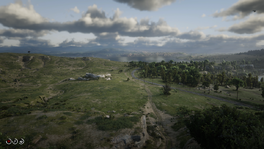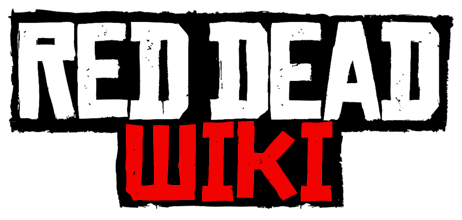mNo edit summary |
No edit summary Tag: Visual edit |
||
| (41 intermediate revisions by 13 users not shown) | |||
| Line 1: | Line 1: | ||
| − | {{Unreleased}} |
||
| − | {{Stub}} |
||
{{Infobox location |
{{Infobox location |
||
| − | |image = |
+ | |image = File:Heartlands1.PNG |
|imagewidth = 300 |
|imagewidth = 300 |
||
| + | |caption = A view of The Heartlands, with Valentine in the foreground |
||
| − | |name ={{PAGENAME}} |
||
| − | | |
+ | |name = The Heartlands |
| − | | |
+ | |game =''[[Red Dead Redemption 2]]'' |
| + | |type = Cold semi-arid plains |
||
|territory = [[New Hanover]] |
|territory = [[New Hanover]] |
||
| − | |region = The Heartlands |
||
|inhabitants = |
|inhabitants = |
||
| − | |image2 = |
+ | |image2 = The Heartlands borders.png |
}} |
}} |
||
| ⚫ | |||
| − | |||
| ⚫ | |||
The capital of the region is [[Valentine]]. This region is the second region the [[Van der Linde gang]] take up residence, after leaving [[Colter]]. |
The capital of the region is [[Valentine]]. This region is the second region the [[Van der Linde gang]] take up residence, after leaving [[Colter]]. |
||
| Line 20: | Line 17: | ||
The region borders [[West Elizabeth]] to the west, [[Cumberland Forest]] to the north, and [[Lemoyne]] to the east. The region's southern border is its shore on [[Flat Iron Lake]]. |
The region borders [[West Elizabeth]] to the west, [[Cumberland Forest]] to the north, and [[Lemoyne]] to the east. The region's southern border is its shore on [[Flat Iron Lake]]. |
||
| ⚫ | The region, with its occasional rainfall, is relatively verdant and full of wildlife. Deer, rabbit, pronghorn, horse, turkey, and goose are common sights. Agriculture, especially cattle ranching, is particularly fruitful in this area. This naturally contributes to [[Valentine]]'s fame as a livestock town. |
||
| ⚫ | |||
| ⚫ | |||
| ⚫ | The region, with its occasional rainfall, is relatively verdant and full of wildlife. Deer, rabbit, pronghorn, horse, turkey, and goose are common sights. Agriculture, especially cattle ranching, is particularly fruitful in this area. |
||
| + | [[File:Heartlands.png|thumb|264x264px|The Heartlands, facing south west from Citadel Rock]] |
||
| + | The Heartlands are high in elevation, on a plateau. This, combined with its northern latitude, contribute to the mild weather. This region most resembles the real-life st especially their western areas. The Heartlands, especially Twin Stack Pass are visually most similar to the Pawnee National Grasslands of Colorado. Its possible that they could be based off the Glass Mountains of Oklahoma, although the the colors of the rock in Heartlands do not reflect the red Permian-aged rock of the Glass Mountains. The Heartland's largest settlement, Valentine seems to be based off several famous frontier towns such as Cheyenne and Deadwood and its early stage of development reflects the 1870's more than the 1890's/1900's. |
||
| ⚫ | |||
| − | == Geography == |
||
| ⚫ | |||
| − | |||
| − | The Heartlands seem to be high in elevation, on a plateau. This, combined with its northern latitude contribute to the mild weather. |
||
| − | |||
| − | This region most resembles the real life state of Nebraska. While Valentine has a lot of similarities to the livestock towns of Dodge City and Wichita, Kansas. |
||
== Locations in The Heartlands == |
== Locations in The Heartlands == |
||
| + | {{columns|2| |
||
* [[Bard's Crossing]] |
* [[Bard's Crossing]] |
||
* [[Caliban's Seat]] |
* [[Caliban's Seat]] |
||
| Line 39: | Line 34: | ||
* [[Citadel Rock]] |
* [[Citadel Rock]] |
||
* [[Cornwall Kerosene & Tar]] |
* [[Cornwall Kerosene & Tar]] |
||
| ⚫ | |||
* [[Cumberland Falls]] |
* [[Cumberland Falls]] |
||
| ⚫ | |||
* [[Dakota River]] |
* [[Dakota River]] |
||
* [[Downes Ranch]] |
* [[Downes Ranch]] |
||
* [[Emerald Ranch]] |
* [[Emerald Ranch]] |
||
* [[Emerald Station]] |
* [[Emerald Station]] |
||
| − | * [[Firwood Rise]] |
||
* [[Flatneck Station]] |
* [[Flatneck Station]] |
||
| + | * [[Gill Landing]] |
||
| ⚫ | |||
| ⚫ | |||
* [[Hani's Bethel]] |
* [[Hani's Bethel]] |
||
* [[Heartland Oil Fields]] |
* [[Heartland Oil Fields]] |
||
| Line 54: | Line 49: | ||
* [[Larned Sod]] |
* [[Larned Sod]] |
||
* [[Limpany]] |
* [[Limpany]] |
||
| + | * [[Lucky's Cabin]] |
||
| + | * [[Oil Derrick]] |
||
| + | * [[Ridge View]] |
||
| + | * [[Trading Post]] |
||
* [[Twin Stack Pass]] |
* [[Twin Stack Pass]] |
||
* [[Valentine]] |
* [[Valentine]] |
||
| + | }} |
||
| + | == Native Plants == |
||
| + | == Wildlife == |
||
| + | {{columns|2| |
||
| + | * [[Badger]] |
||
| + | * [[Bison]] |
||
| + | * [[Blue Jay]] |
||
| + | * [[Buck (RDR 2)|Buck]] |
||
| + | * [[Bull (RDR 2)|Bull]] |
||
| + | * [[Cardinal]] |
||
| + | * [[Chicken (RDR 2)|Chicken]] |
||
| + | * [[Chipmunk]] |
||
| + | * [[Cormorant]] |
||
| + | * [[Cow (RDR 2)|Cow]] |
||
| + | * [[Crow (RDR 2)|Crow]] |
||
| + | * [[Coyote (RDR 2)|Coyote]] |
||
| + | * [[Deer (RDR 2)|Deer]] |
||
| + | * [[Duck (RDR 2)|Duck]] |
||
| + | * [[Eagle (RDR 2)|Eagle]] |
||
| + | * [[Fox (RDR 2)|Fox]] |
||
| + | * [[Goat (RDR 2)|Goat]] |
||
| + | * [[Goose]] |
||
| + | * [[Gull]] |
||
| + | * [[Hawk (RDR 2)|Hawk]] |
||
| + | * [[Loon]] |
||
| + | * [[Muskrat]] |
||
| + | * [[Opossum]] |
||
| + | * [[Oriole]] |
||
| + | * [[Owl (RDR 2)|Owl]] |
||
| + | * [[Oxen]] |
||
| + | * [[Pheasant]] |
||
| + | * [[Pig (RDR 2)|Pig]] |
||
| + | * [[Pigeon]] |
||
| + | * [[Pronghorn]] |
||
| + | * [[Quail]] |
||
| + | * [[Rabbit (RDR 2)|Rabbit]] |
||
| + | * [[Raccoon (RDR 2)|Raccoon]] |
||
| + | * [[Rat]] |
||
| + | * [[Robin]] |
||
| + | * [[Rooster]] |
||
| + | * [[Skunk (RDR 2)|Skunk]] |
||
| + | * [[Snake (RDR 2)|Snake]] |
||
| + | * [[Songbird (RDR 2)|Songbird]] |
||
| + | * [[Sparrow]] |
||
| + | * [[Squirrel]] |
||
| + | * [[Toad]] |
||
| + | * [[Turkey]] |
||
| + | * [[Vulture (RDR 2)|Vulture]] |
||
| + | * [[Woodpecker]] |
||
| + | }} |
||
| + | == Navigation == |
||
| + | {{Redemption 2 Locations}} |
||
{{RDRII}} |
{{RDRII}} |
||
| + | {{Related Content}} |
||
| + | [[de:Heartlands]] |
||
| + | [[fr:Heartlands]] |
||
[[it:The Heartlands]] |
[[it:The Heartlands]] |
||
| + | [[pt-br:Heartlands]] |
||
[[Category:Redemption II Locations]] |
[[Category:Redemption II Locations]] |
||
[[Category:New Hanover]] |
[[Category:New Hanover]] |
||
Revision as of 00:29, 20 May 2020
The Heartlands is a constituent region of the New Hanover territory in Red Dead Redemption 2.
The capital of the region is Valentine. This region is the second region the Van der Linde gang take up residence, after leaving Colter.
Description
The region borders West Elizabeth to the west, Cumberland Forest to the north, and Lemoyne to the east. The region's southern border is its shore on Flat Iron Lake.
The region, with its occasional rainfall, is relatively verdant and full of wildlife. Deer, rabbit, pronghorn, horse, turkey, and goose are common sights. Agriculture, especially cattle ranching, is particularly fruitful in this area. This naturally contributes to Valentine's fame as a livestock town.
The landscape features of the Heartlands include rolling hills, scattered buttes, rocky outcrops, small stands of timber, and open plains. Ranches, farms, and small homesteads dot the otherwise open grassland.

The Heartlands, facing south west from Citadel Rock
The Heartlands are high in elevation, on a plateau. This, combined with its northern latitude, contribute to the mild weather. This region most resembles the real-life st especially their western areas. The Heartlands, especially Twin Stack Pass are visually most similar to the Pawnee National Grasslands of Colorado. Its possible that they could be based off the Glass Mountains of Oklahoma, although the the colors of the rock in Heartlands do not reflect the red Permian-aged rock of the Glass Mountains. The Heartland's largest settlement, Valentine seems to be based off several famous frontier towns such as Cheyenne and Deadwood and its early stage of development reflects the 1870's more than the 1890's/1900's.
The climate of the Heartlands is mild. Temperatures range from near freezing at night and in the mornings, to around 60 degrees during the afternoon. Most days are sunny. However, rain and even thunderstorms occur occasionally.
Locations in The Heartlands
- Bard's Crossing
- Caliban's Seat
- Carmody Dell
- Castor's Ridge
- Chadwick Farm
- Citadel Rock
- Cornwall Kerosene & Tar
- Cumberland Falls
- Dakota River
- Downes Ranch
- Emerald Ranch
- Emerald Station
- Flatneck Station
- Gill Landing
- Granger's Hoggery
- Guthrie Farm
- Hani's Bethel
- Heartland Oil Fields
- Heartland Overflow
- Horseshoe Overlook
- Larned Sod
- Limpany
- Lucky's Cabin
- Oil Derrick
- Ridge View
- Trading Post
- Twin Stack Pass
- Valentine
Native Plants
Wildlife
| ||||||||||||||||||||||||||||||||
| |||||||||||
